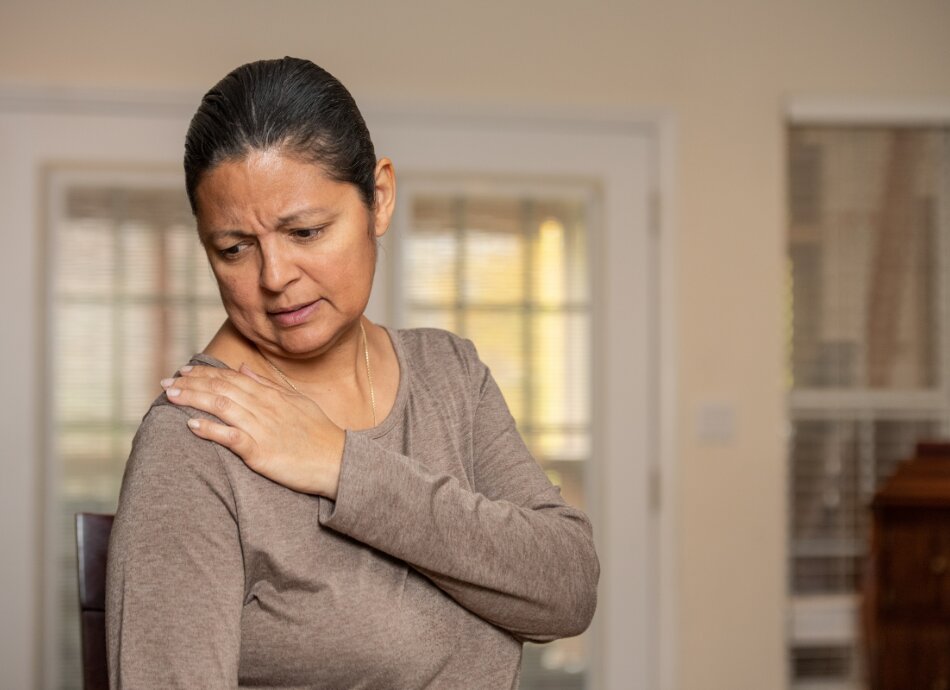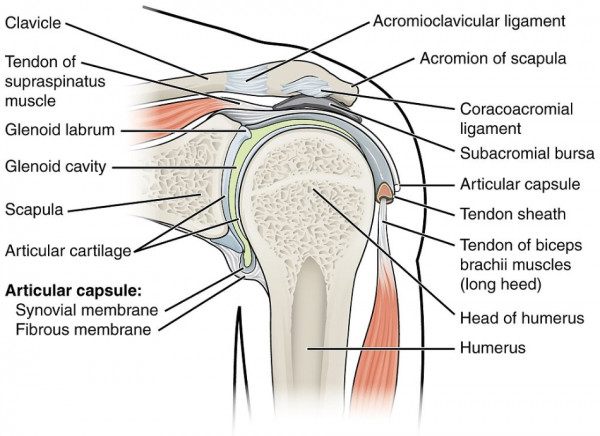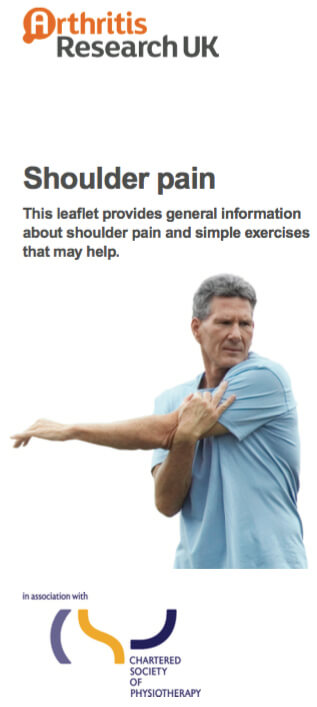Wishing everyone a safe and happy Christmas and New Year – Meri Kirihimete from the Healthify team.
Shoulder pain
Key points about shoulder pain
- Shoulder pain is a common problem that can affect you at any age. It can happen as a result of an accident or injury or can be part of the natural ageing process.
- It's rarely a sign of a more serious problem but sudden severe shoulder pain may be a sign of a heart attack. if you have shoulder pain radiating down your arm or have a tight feeling across your chest and shortness of breath call 111 immediately.
- Most shoulder pain settles over a few weeks.
- Find out how you can manage the pain, including exercises to do, and when to seek help.

Shoulder pain is rarely a sign of a more serious problem. But sudden severe shoulder pain may be a sign of a heart attack.
If you feel shoulder pain that's radiating down your arm or you’re experiencing a tight feeling across the chest and shortness of breath, call 111 immediately.
You should see your GP, urgent doctor, physiotherapist or other healthcare provider if any of the following apply:
- The pain is getting worse rather than better, despite following self-management or initial pain medication.
- There's a possibility of a fracture or dislocation (go to the emergency department or Urgent Doctors if you suspect a fracture or dislocation).
- You're unable to lift your arm.
- You have pain at night, possibly worse than during that day, that stops you sleeping.
- You have tingling (pins and needles), numbness or a burning feeling in your arm, hand or fingers.
- There's blueness or a cold feeling in your arm, hand or fingers.
- The joint is becoming hot and swollen.
- You feel unwell, and have symptoms, eg, a fever, night sweats or weight loss.
Your shoulder is perfectly designed for its function, which is to place or move your hand into the position and direction that's needed for the task. That might be taking a cup out of the cupboard, hammering a nail into the wall or throwing a ball.
The muscles of your shoulder and shoulder blade (scapula) work together in thousands of different coordinated patterns. Your brain can change those patterns in a split-second, to protect your shoulder and for the movement to be as effective as possible.
The image below shows the bones and tendons of the shoulder.

Image credit: OpenStax College via Wikimedia Commons(external link)
Causes of shoulder pain can be divided into the following:
- painful shoulder
- stiff shoulder
- loose shoulder
- other shoulder conditions.
The painful shoulder
Rotator cuff related shoulder pain: The rotator cuff is a group of muscles and tendons that surround your shoulder joint, keeping the head of your upper arm bone firmly within the socket of the shoulder. Pain associated with the tendon is often called a ‘tendinopathy’ or ‘tendinitis’. A tear of the tendon may also be present, or the bursa (small fluid-filled sacks which cushion the tendons and capsule) can be temporarily inflamed. This condition has also been called a 'tendinitis', 'impingement' or 'bursitis'. Changes like these can also be part of normal ageing. Instead of finding out exactly what is causing the pain, it's more important to find out what treatment can help your pain, or what you can do yourself to manage the pain.
The stiff shoulder
Frozen shoulder: A frozen shoulder can cause severe pain and stiffness in your shoulder. It may have 2 phases – first the pain is worse than the stiffness, then the stiffness is worse than the pain. It can often come on without a cause, but in some cases it can develop after surgery or an injury. It can also be more common in people with diabetes. Recovery can be slow and may take more than a year. If you think you have a frozen shoulder, you should see your healthcare provider to find out if there's an underlying reason for the condition.
Osteoarthritis: This is the most common form of arthritis affecting people as they get older. Read more about osteoarthritis.
The loose shoulder
Dislocated or subluxed shoulder: These injuries are usually due to an injury or an accident, eg, a fall. If you felt your shoulder dislocate (pop out), you should go to the emergency department (ED) as your shoulder may need to be put back into place. An X-ray or other investigation is usually needed to check for a fracture or another injury.
Instability or increased flexibility: A 'loose' shoulder can be due to an instability following an injury, or due to hypermobility or flexibility. If you have a shoulder instability you may experience an occasional subluxation (when a bone is partly out of a joint) without a full dislocation. This means the shoulder can move back into place by itself.
Other shoulder conditions
Fractures: Various bones in your shoulder can fracture – including your shoulder blade, collarbone and upper arm. If you suspect a fracture after an injury, you should go to your hospital emergency department.
Acromioclavicular joint pain: This joint is at the tip of your shoulder between your shoulder blade and collar bone (see the image above). The joint can be injured by falling directly onto your shoulder, eg, during a skiing fall, when falling off a mountain bike or when playing a contact sport.
Nerve injuries: A number of nerves supply your shoulder. These can be injured during an accident or fall or can develop symptoms due to other reasons, eg, a ganglion or cyst developing on the nerve. If the nerve is injured, you'll have pain in the specific area supplied by the nerve, pins and needles, loss of sensation to the skin that is supplied by the nerve, and weakness of specific muscles. If you suspect a nerve injury, you should talk to your healthcare provider.
Most shoulder pain will settle over time and often a precise reason for the pain doesn't need to be understood. Here are a few things you can do to help your shoulder pain.
Things to do
- Be patient: Your shoulder pain will usually improve gradually over a few weeks, even if there has been an injury. You may find wearing a support or a sling for a few days helpful. In the early phase of your pain, or when you have a flare-up, try to avoid the movements that make your pain worse.
- Work out what relieves your shoulder pain: People respond differently to treatment. This might include changing your arm position or posture during your work, hobbies and sports. Try to find out whether the pain gets worse when you're feeling stressed or anxious about things.
- Cooling or warmth can help: This can be done by applying an ice bag or frozen peas wrapped in a towel for about 15 to 20 minutes. Some people find that applying a warm wheat bag for 20 to 30 minutes several times per day is more effective than applying ice.
- Pacing: This means that you 'chunk' tasks into shorter time periods, and rest or do other tasks in between.
- Keep active: Activity may be painful but not harmful. A small increase in pain while exercising is okay as long as it goes away within 30 minutes and is not worse the next day. If it happens, don’t worry, do fewer repetitions the next time. Planning and pacing are important for recovery. Exercise is important for your general health, the healing process, and for your bone and muscle health.
- Sleep: Have regular sleep patterns (read more about good sleep habits). If you have pain at night, try using a pillow under the arm of your sore shoulder when lying on the other side. You can also try a pillow behind your back so you can lie at an angle without putting pressure on your shoulder. These may put your shoulder in a more comfortable position.
- Wellbeing: Maintaining a positive attitude and good physical health is important to your recovery and overall wellbeing.
Things to avoid
- Avoid doing things that make your shoulder pain worse. Avoid overexertion or overdoing your normal activities.
- Don’t completely stop using your shoulder. Not using your shoulder can delay healing and may make your shoulder pain worse over time.
If you're concerned about your shoulder pain, make an appointment with your healthcare provider (eg, a physiotherapist or your doctor). Read more about treatment below.
If you're concerned about shoulder pain, see your healthcare provider or a physiotherapist. You can be assessed by a physiotherapist without a referral from a GP.
Your healthcare provider will ask you questions about your shoulder, when the pain started and how it affects your daily life. They will also perform a physical examination and discuss treatment options with you.
Further testing isn't normally needed, but if your pain persists, your physiotherapist or healthcare provider may suggest blood tests, an X-ray or an ultrasound scan.
Physiotherapy
Physiotherapy is one of the most common treatments for shoulder pain. Physiotherapists will:
- Assess your shoulder pain and movement limitations, and discuss the best way to address these.
- Explore ways to modify your daily tasks, work and sports/recreational activities so you can continue with them.
- Teach you exercises to help with reducing pain and strengthening your shoulder. In addition to exercises, manual therapy, massage or miri miri can be used to manage pain.
- Provide advice for general exercise for general health.
- Give you guidance for returning to sport and recreation. As you recover they can help you develop a plan, programme or strategies that are specific for you.
Read more about non-medicine approaches to managing pain.
Medicines
Pain-relieving medicines (eg, paracetamol and anti-inflammatories) can help to reduce your pain and swelling. These are best used for a short time only and are not usually a long-term solution. If your pain persists, your healthcare provider may recommend a corticosteroid injection into the joint. Read more about pain relief medicines.
Surgery
Surgery may be an option if other treatments haven't worked. Surgery may be used to treat rotator cuff tears if the tear is large and if other treatment options haven't worked after 3 to 6 months. Joint replacement surgery may be an option for osteoarthritis of the shoulder if you have persistent shoulder pain that seriously interferes with daily life.
A set of New Zealand videos demonstrating helpful exercises can be found on the Otago Shoulder Health Project website(external link) and they're also linked below.
Check with your healthcare provider or physiotherapist if these are suitable for you.
Video: Exercise 1 – shoulder rolls
Video: Exercise 2 – shoulder statics
Video: Exercise 3: "Accordion" twists
Video: Exercise 4 – elbow rolls
Video: Exercise 5 – wall glides
Video: Exercise 6 – wall presses
Apps reviewed by Healthify
You may find it useful to look at some Physiotherapy and exercise apps and Pain management apps.
Shoulder pain(external link) University of Otago
Knowing about your rotator cuff disorder(external link) ACC, NZ
Rotator cuff tear(external link) Ortho.Info American Academy of Orthopedic Surgeons
Subacromial shoulder pain(external link) British Elbow & Shoulder Society, UK
Lewis J. An open letter to you, a unique individual living with shoulder pain(external link) IMAJ;24:410-416
Apps
Physiotherapy and exercise apps
Pain management apps
Brochures
Rotator cuff and shoulder conditioning program(external link) American Academy of Orthopaedic Surgeons
Shoulder pain [PDF, 758 KB] Arthritis Research UK
References
- Shoulder pain(external link) University of Otago, NZ
- Shoulder pain management treatment options(external link) University of Otago, NZ
Shoulder examination
Shoulder injuries or aches and pains are common and learning to do an effective shoulder examination is essential. For those of us who have been practising for years, it can still be worth reviewing our techniques and upskilling ourselves!
The standard order is: Look, feel, move, special tests.
Video: Shoulder examination – orthopaedics (9.31 mins)
This video provides another perspective on the shoulder examination and has been produced by students at Oxford University Medical School in conjunction with the faculty. It's part of a series of videos covering Orthopaedic examinations and is linked to Oxford Medical Education.(external link) This video may take a few moments to load.
(Oxford Medical Education, UK, 2012)
Apps
Brochures

American Academy of Orthopaedic Surgeons, 2022

Arthritis Research UK
Credits: Healthify editorial team. Healthify is brought to you by Health Navigator Charitable Trust.
Reviewed by: Professor Gisela Sole, School of Physiotherapy, University of Otago
Last reviewed:





